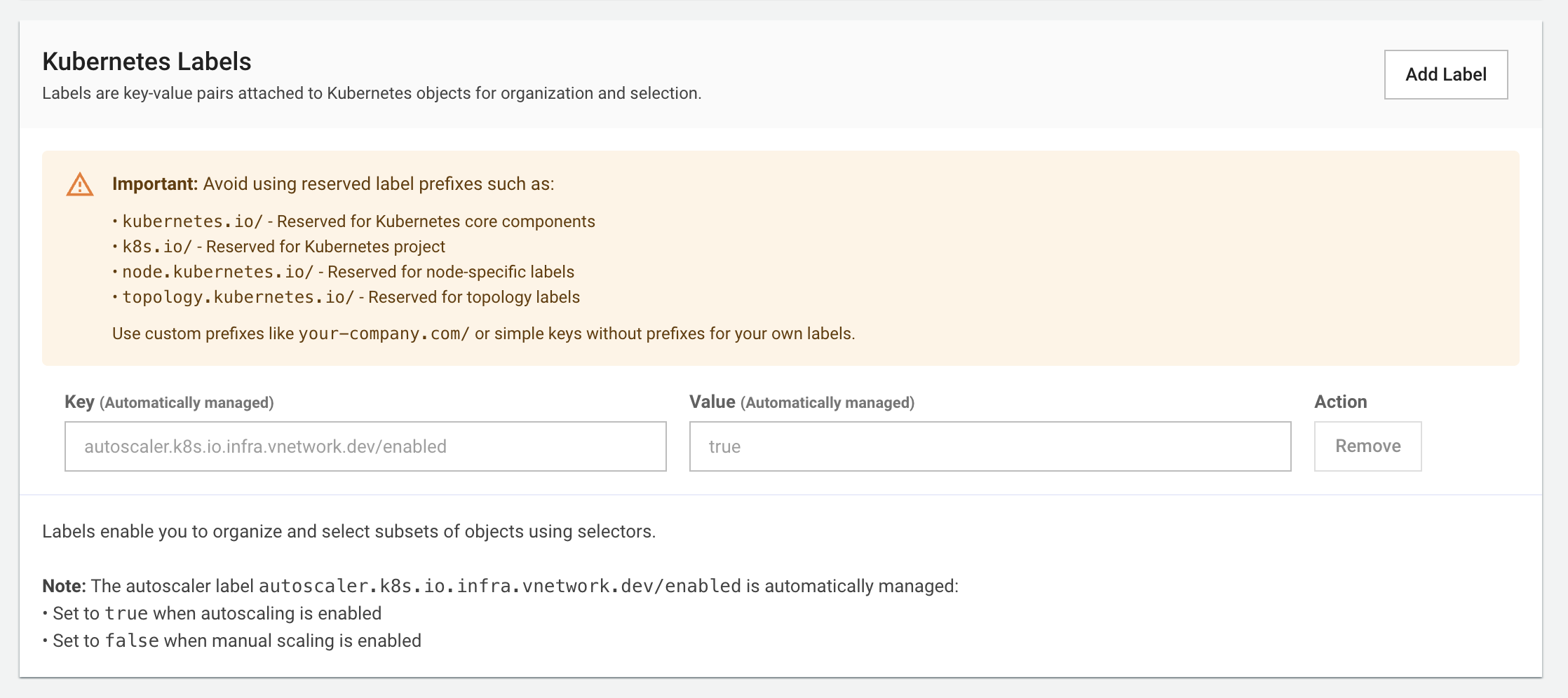Advanced Scaling
Enterprise-grade scaling configurations and automation strategies.
Auto-Discovery Configuration
Cluster Autoscaler Integration
Enable automatic NodeGroup discovery using tag-based configuration:
--node-group-auto-discovery=vcloud:autoscaler.k8s.io.infra.vnetwork.dev/enabled=true
Configuration Components:
- Provider:
vcloud- Specifies vCloud infrastructure provider - Tag Key:
autoscaler.k8s.io.infra.vnetwork.dev/enabled - Tag Value:
true- Enables auto-discovery for tagged NodeGroups
 Kubernetes labels showing autoscaler configuration with automatically managed label
Kubernetes labels showing autoscaler configuration with automatically managed label
Benefits:
- Automatic NodeGroup detection by cluster autoscaler
- Eliminates manual NodeGroup configuration
- Dynamic scaling based on resource demand
- Simplified autoscaler setup and maintenance
Note: The autoscaler label autoscaler.k8s.io.infra.vnetwork.dev/enabled is automatically managed:
- Set to
truewhen autoscaling is enabled - Set to
falsewhen manual scaling is enabled
Multi-Pattern Discovery
# Environment-based discovery
--node-group-auto-discovery=vcloud:autoscaler.k8s.io.infra.vnetwork.dev/environment=production
# Workload-specific discovery
--node-group-auto-discovery=vcloud:autoscaler.k8s.io.infra.vnetwork.dev/workload-type=compute-optimized
Multi-Dimensional Scaling
Horizontal Pod Autoscaler (HPA) Integration
Combined Scaling Approach:
- HPA manages replica count based on metrics
- Cluster autoscaler manages node count based on pod scheduling needs
- Coordinated operation for optimal resource utilization
HPA Configuration Example:
apiVersion: autoscaling/v2
kind: HorizontalPodAutoscaler
metadata:
name: application-hpa
spec:
scaleTargetRef:
apiVersion: apps/v1
kind: Deployment
name: application-deployment
minReplicas: 3
maxReplicas: 100
metrics:
- type: Resource
resource:
name: cpu
target:
type: Utilization
averageUtilization: 70
- type: Resource
resource:
name: memory
target:
type: Utilization
averageUtilization: 80
Vertical Pod Autoscaler (VPA)
Resource Right-Sizing:
- Automatic resource recommendations based on usage patterns
- Optimal CPU and memory requests/limits
- Better resource utilization during scaling
- Cost optimization through accurate allocation
Custom Metrics and Triggers
Application-Specific Scaling
Business Metrics:
- Queue depth for message processing applications
- Response time for latency-sensitive services
- Request rate for traffic-based scaling
- Error rate indicators for resource stress
External Metrics:
- Database connection pool utilization
- Cache hit ratio performance
- Third-party API response times
- Business event-driven scaling
Predictive Scaling
Machine Learning-Based Scaling:
- Historical pattern analysis for recurring usage patterns
- Seasonal adjustments for daily, weekly, monthly cycles
- Trend analysis for long-term capacity planning
- Anomaly detection for unusual patterns
Advanced Verification
Multi-Layer Verification
Infrastructure Verification:
# Verify NodeGroup configuration
kubectl get nodegroup NODEGROUP_NAME -o yaml
# Check node labels and taints
kubectl get nodes --show-labels | grep NODEGROUP_SELECTOR
# Verify resource allocation
kubectl describe nodes | grep -A10 "Allocated resources"
# Check cluster autoscaler status
kubectl get configmap cluster-autoscaler-status -n kube-system -o yaml
Application Health Verification:
# Check pod distribution across nodes
kubectl get pods -o custom-columns=NAME:.metadata.name,NODE:.spec.nodeName,STATUS:.status.phase
# Verify service endpoints
kubectl get endpoints SERVICE_NAME -o yaml
# Check application metrics
kubectl top pods --sort-by=cpu
# Validate load balancer configuration
kubectl get services -o wide